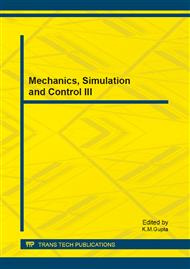p.136
p.141
p.145
p.151
p.156
p.161
p.165
p.171
p.181
Finite Element Formulation for the Vibration Analysis of Couple-Stress Continuum
Abstract:
This paper proposed a finite element formulation to analysis the vibration of couple-stress continuum. A four-node discrete couple-stress element relaxed the requirement of C1 continuity is developed. This element is modified by a bubble function, based on the classical four-ode Lagrange element. The element includes the internal bending constants and the internal initial moment of rotation. Numerical examples show that the present FE scheme is accurate for the eigenvalue analysis of couple-stress continuum structures, especially for the low order frequency analysis.
Info:
Periodical:
Pages:
156-160
Citation:
Online since:
August 2013
Authors:
Price:
Сopyright:
© 2013 Trans Tech Publications Ltd. All Rights Reserved
Share:
Citation:


